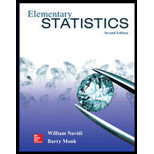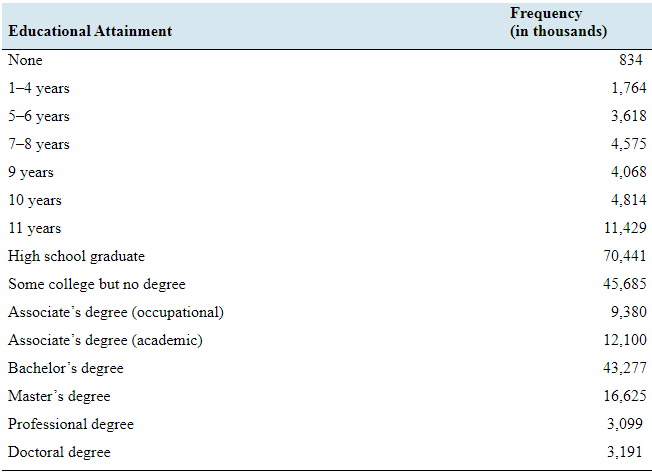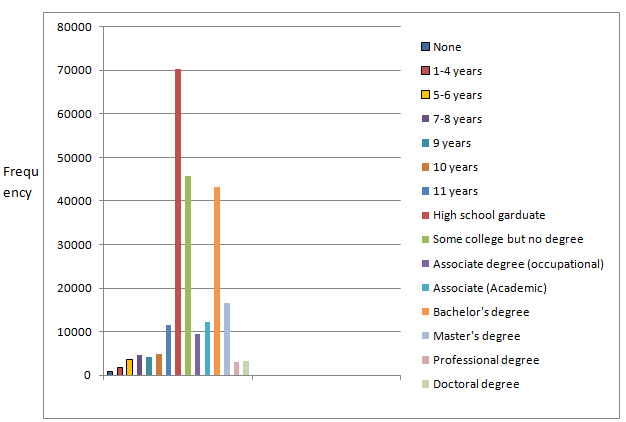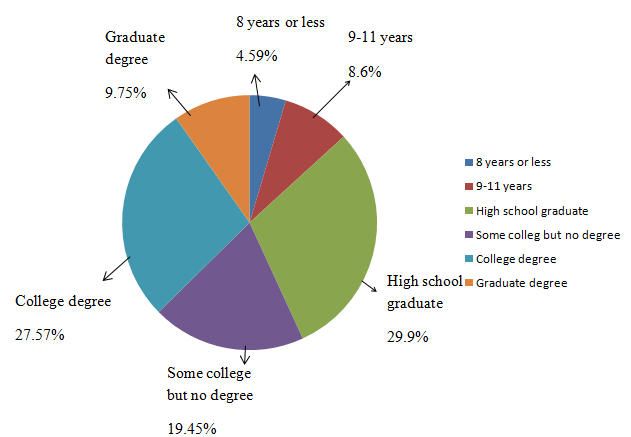
Education levels: The following frequency distribution categorizes US. adults aged 18 and over by educational attainment in a recent year.

- Construct a frequency bar graph.
- Construct a relative frequency distribution.
- Construct a relative frequency bar graph.
- Construct a frequency distribution with the following categories: 8 years or less, 9—11 years, High school graduate, Some college but no degree: College degree (Associate’s or Bachelor’s): Graduate degree Master’s, Professional, or Doctoral).
- Construct a pie chart for the frequency distribution in part (d).
- What proportion of people did not graduate from high school?
a.
To construct: A frequency bar graph.
Explanation of Solution
Given information: The following frequency distribution categorises U.S. adults aged 18 and over by educational attainment in a recent year.
| Educational attainment | Frequency(in thousands) |
| None | 834 |
| 1-4 years | 1764 |
| 5-6 years | 3618 |
| 7-8 years | 4575 |
| 9 years | 4068 |
| 10 years | 4814 |
| 11 years | 11429 |
| High school graduate | 70441 |
| Some college but no degree | 45685 |
| Associates degree (Occupational) | 9380 |
| Associates degree (Academic) | 12100 |
| Bachelor’s degree | 43277 |
| Master’s degree | 16625 |
| Professional degree | 3099 |
| Doctoral degree | 3191 |
Solution:
From the given table, the frequency bar graph is given by

b.
To construct: The relative frequency distribution.
Explanation of Solution
Given information:The following frequency distribution categorises U.S. adults aged 18 and over by educational attainment in a recent year.
| Educational attainment | Frequency(in thousands) |
| None | 834 |
| 1-4 years | 1764 |
| 5-6 years | 3618 |
| 7-8 years | 4575 |
| 9 years | 4068 |
| 10 years | 4814 |
| 11 years | 11429 |
| High school graduate | 70441 |
| Some college but no degree | 45685 |
| Associates degree (Occupational) | 9380 |
| Associates degree (Academic) | 12100 |
| Bachelor’s degree | 43277 |
| Master’s degree | 16625 |
| Professional degree | 3099 |
| Doctoral degree | 3191 |
Formula used:
Calculation:
From the given table,
The sum of all frequency is
The table of relative frequency is given by
| Educational attainment | Frequency(in thousands) | Relative frequency |
| None | 834 | |
| 1-4 years | 1764 | |
| 5-6 years | 3618 | |
| 7-8 years | 4575 | |
| 9 years | 4068 | |
| 10 years | 4814 | |
| 11 years | 11429 | |
| High school graduate | 70441 | |
| Some college but no degree | 45685 | |
| Associates degree (Occupational) | 9380 | |
| Associates degree (Academic) | 12100 | |
| Bachelor’s degree | 43277 | |
| Master’s degree | 16625 | |
| Professional degree | 3099 | |
| Doctoral degree | 3191 |
c.
To construct: A relative frequency bar graph.
Explanation of Solution
Given information:The following frequency distribution categorises U.S. adults aged 18 and over by educational attainment in a recent year.
| Educational attainment | Frequency(in thousands) |
| None | 834 |
| 1-4 years | 1764 |
| 5-6 years | 3618 |
| 7-8 years | 4575 |
| 9 years | 4068 |
| 10 years | 4814 |
| 11 years | 11429 |
| High school graduate | 70441 |
| Some college but no degree | 45685 |
| Associates degree (Occupational) | 9380 |
| Associates degree (Academic) | 12100 |
| Bachelor’s degree | 43277 |
| Master’s degree | 16625 |
| Professional degree | 3099 |
| Doctoral degree | 3191 |
Definition used:
Histogram based on relative frequency is called relative frequency histogram.
Solution:
The following table gives the relative frequency.
| Educational attainment | Relative frequency |
| None | 0.0036 |
| 1-4 years | 0.0075 |
| 5-6 years | 0.0154 |
| 7-8 years | 0.0195 |
| 9 years | 0.0173 |
| 10 years | 0.0205 |
| 11 years | 0.0487 |
| High school graduate | 0.2999 |
| Some college but no degree | 0.1945 |
| Associates degree (Occupational) | 0.0399 |
| Associates degree (Academic) | 0.0515 |
| Bachelor’s degree | 0.184 |
| Master’s degree | 0.0708 |
| Professional degree | 0.0132 |
| Doctoral degree | 0.0136 |
From the above table, the relative frequency bar graph is given by

d.
To construct: A frequency distribution with the following categories: 8 years or less, 9-11 years, High school graduate, Some college but no degree, College degree (Associate’s or Bachelor’s), Graduate degree (Master’s, professional, or Doctoral)
Answer to Problem 28E
| Educational attainment | Frequency(in thousands) |
| 8 years or less | 10791 |
| 9-11 years | 20311 |
| High school graduate | 70441 |
| Some college but no degree | 45685 |
| College degree (Associate’s or Bachelor’s) | 64757 |
| Graduate degree (Master’s, professional, or Doctoral) | 22915 |
Explanation of Solution
Given information:The following frequency distribution categorises U.S. adults aged 18 and over by educational attainment in a recent year.
| Educational attainment | Frequency(in thousands) |
| None | 834 |
| 1-4 years | 1764 |
| 5-6 years | 3618 |
| 7-8 years | 4575 |
| 9 years | 4068 |
| 10 years | 4814 |
| 11 years | 11429 |
| High school graduate | 70441 |
| Some college but no degree | 45685 |
| Associates degree (Occupational) | 9380 |
| Associates degree (Academic) | 12100 |
| Bachelor’s degree | 43277 |
| Master’s degree | 16625 |
| Professional degree | 3099 |
| Doctoral degree | 3191 |
Solution:
The required frequency distribution with the given categories is given by
| Educational attainment | Frequency(in thousands) |
| 8 years or less | |
| 9-11 years | |
| High school graduate | 70441 |
| Some college but no degree | 45685 |
| College degree (Associate’s or Bachelor’s) | |
| Graduate degree (Master’s, professional, or Doctoral) |
e.
To construct: A pie chart
Explanation of Solution
Given information: The following frequency distribution categorises U.S. adults aged 18 and over by educational attainment in a recent year.
| Educational attainment | Frequency(in thousands) |
| 8 years or less | 10791 |
| 9-11 years | 20311 |
| High school graduate | 70441 |
| Some college but no degree | 45685 |
| College degree (Associate’s or Bachelor’s) | 64757 |
| Graduate degree (Master’s, professional, or Doctoral) | 22915 |
Solution:
From the given table, the percentage of each gender and age group is given by
| Educational attainment | Frequency(in thousands) | Relative frequency | Percentage |
| 8 years or less | 10791 | 0.0459 | 4.59 % |
| 9-11 years | 10311 | 0.086 | 8.6% |
| High school graduate | 70441 | 0.299 | 29.9% |
| Some college but no degree | 45685 | 0.1945 | 19.45% |
| College degree (Associate’s or Bachelor’s) | 64757 | 0.2757 | 27.57% |
| Graduate degree (Master’s, professional, or Doctoral) | 22915 | 0.0975 | 9.75% |
From the above table, the pie chart is given by

f.
To find: The proportion of people did not graduate from high school.
Answer to Problem 28E
The proportion of people did not graduate from high school is 0.132.
Explanation of Solution
Given information:The following frequency distribution categorises U.S. adults aged 18 and over by educational attainment in a recent year.
| Educational attainment | Frequency(in thousands) |
| 8 years or less | 10791 |
| 9-11 years | 20311 |
| High school graduate | 70441 |
| Some college but no degree | 45685 |
| College degree (Associate’s or Bachelor’s) | 64757 |
| Graduate degree (Master’s, professional, or Doctoral) | 22915 |
Solution:
From the given table, the percentage of each gender and age group is given by
| Educational attainment | Frequency(in thousands) | Relative frequency |
| 8 years or less | 10791 | 0.0459 |
| 9-11 years | 20311 | 0.086 |
| High school graduate | 70441 | 0.299 |
| Some college but no degree | 45685 | 0.1945 |
| College degree (Associate’s or Bachelor’s) | 64757 | 0.2757 |
| Graduate degree (Master’s, professional, or Doctoral) | 22915 | 0.0975 |
The people did not graduate from high school are people whose educations are 8 years or less and 9-11 years.
The proportion of people did not graduate from high school is
Hence, the proportion of people did not graduate from high school is 0.132.
Want to see more full solutions like this?
Chapter 2 Solutions
Elementary Statistics (Text Only)
- Show all workarrow_forwardplease find the answers for the yellows boxes using the information and the picture belowarrow_forwardA marketing agency wants to determine whether different advertising platforms generate significantly different levels of customer engagement. The agency measures the average number of daily clicks on ads for three platforms: Social Media, Search Engines, and Email Campaigns. The agency collects data on daily clicks for each platform over a 10-day period and wants to test whether there is a statistically significant difference in the mean number of daily clicks among these platforms. Conduct ANOVA test. You can provide your answer by inserting a text box and the answer must include: also please provide a step by on getting the answers in excel Null hypothesis, Alternative hypothesis, Show answer (output table/summary table), and Conclusion based on the P value.arrow_forward
- A company found that the daily sales revenue of its flagship product follows a normal distribution with a mean of $4500 and a standard deviation of $450. The company defines a "high-sales day" that is, any day with sales exceeding $4800. please provide a step by step on how to get the answers Q: What percentage of days can the company expect to have "high-sales days" or sales greater than $4800? Q: What is the sales revenue threshold for the bottom 10% of days? (please note that 10% refers to the probability/area under bell curve towards the lower tail of bell curve) Provide answers in the yellow cellsarrow_forwardBusiness Discussarrow_forwardThe following data represent total ventilation measured in liters of air per minute per square meter of body area for two independent (and randomly chosen) samples. Analyze these data using the appropriate non-parametric hypothesis testarrow_forward
 Holt Mcdougal Larson Pre-algebra: Student Edition...AlgebraISBN:9780547587776Author:HOLT MCDOUGALPublisher:HOLT MCDOUGAL
Holt Mcdougal Larson Pre-algebra: Student Edition...AlgebraISBN:9780547587776Author:HOLT MCDOUGALPublisher:HOLT MCDOUGAL Glencoe Algebra 1, Student Edition, 9780079039897...AlgebraISBN:9780079039897Author:CarterPublisher:McGraw Hill
Glencoe Algebra 1, Student Edition, 9780079039897...AlgebraISBN:9780079039897Author:CarterPublisher:McGraw Hill Big Ideas Math A Bridge To Success Algebra 1: Stu...AlgebraISBN:9781680331141Author:HOUGHTON MIFFLIN HARCOURTPublisher:Houghton Mifflin Harcourt
Big Ideas Math A Bridge To Success Algebra 1: Stu...AlgebraISBN:9781680331141Author:HOUGHTON MIFFLIN HARCOURTPublisher:Houghton Mifflin Harcourt


